IPC Plenary Open Meetings, Vienna 2014 29th & 30th January
Welcome to Austria and this year's Plenary Meeting.
29th January, 2014
Today we start the open meetings where each committee will present their proposed changes to all the delegates and allow full discussion - no one will be voting until the formal Plenary at the weekend.
The agenda with annexes is available on this link.
The open meetings will be interspersed with closed committee meetings as everyone works towards preparing their presentation for the Plenary.
9.00 am Start of the open meeting –

Graeme Windsor, President of IPC, welcomes all the delegates – all here to do the same thing – look after the future of parachuting. Thanks to the Austrian Aeroclub for their organisation of this meeting.
Review of the Strategic Plan, since initiation after Graeme’s appointment has gone through annual reviews, always looking for improvements – key words Attractive and Dynamic.
Graeme talked through the 5 points of the plan and commented on the fulfilment and future of these aims.
During the plenary consider the aims of the plan and ask yourselves if the decisions you will make will fulfil or move towards fulfilment of this plan.
Graeme then talked about the FAI, changes in their management with the appointment of a new Secretary General. He also spoke about the Breitling sponsorship of the FAI and how this could work for the IPC in terms of compensation for unsupported First Category Events.
IPETA will hold its 1st AGM tonight and will be reported on at that time.
Code of Excellence – will be discussed and utilised for all meetings and competitions and is an initiative instigated by Niels-Christian Levin Hansen, Vice President.
Bosnia & Herzegovina NAC had a meeting with the bureau as they have suspended the club at Banja Luka and wish to substitute a different organiser for this year’s World Championships in Freefall Style and Accuracy and Canopy Formation. This will be discussed further during the coming days.
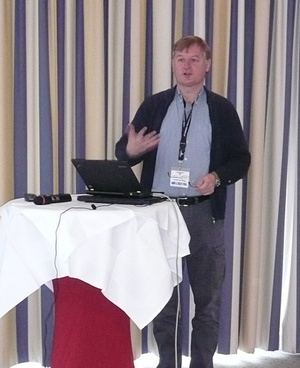
Niels-Christian Levin Hansen then introduced the Technical and Safety Committee with apologies from those committee members who could not be here this time.
Safety is part of the Strategic Plan and the committee recognises that each country has its own safety rules, but the committee sees a need to share information and that IPC becomes the central disseminator of information.
2013 Collecting statistics and distribution of Safety Report
Distribution of Information Notices (INs)
Input to FAI Expert Group on Safety
Niels-Christian publicly thanked Liam McNulty for his work in collecting, collating and distributing all this information.
Niels-Christian then explained his involvement with the FAI Expert Group on Safety in an effort to ensure that any “Expert” input on parachuting is from the IPC. That he prevents any effort to create regulations that try to form an overall control of our airsports, but that in fact it becomes like our committee, one to collect and collate information on issues within their own airsports.
He then appealed to all delegates to ensure that in their country they do respond and send in an annual safety report.
The T&S committee will in the coming year seek closer ties with the parachute industry through the Parachute Industry Association (PIA) and directly with the individual manufacturers.
Data Collecting Tool – a lot of work had been done to establish this by Elisabet Mikaelsson and although this suffered a breakdown with the crashing of the FAI server – it has now been reinstalled and is working, but it is not being used by NACs and the continued use of this tool will be discussed by the committee.
Certificates of Proficiency – have now been reprinted and are available and please continue to utilise this tool.
New Members on the committee – Niels-Christian asked for any person who felt they could work on this committee.
Ronald Overdijk from the floor, suggested the committee worked at also publicising the safety of our sport to try and overcome the impression that Parachuting is a “dangerous “ sport and that affects the ability to attract sponsors.

Members of the Safety and Training Committee

The open meeting of the Finance working group introduced by Buzz Bennett and committee of Doris Herz and Johann Gritsch. Buzz announced that this was almost his last presentation as he was retiring at the end of this meeting. Buzz then went on to explain why the FAI was having accounting problems – the Secretary General before last introduced accounting software that was not workable in Switzerland. This has now been changed to a new system based on Swiss tax and accounting laws. The change over has caused major work and problems within the FAI office.
Last year Buzz had been unable to finalise the 2012 due to these not being finalised by the FAI and for a variety of reasons it was not until June until the final figures were available. However on these figures Buzz found that the FAI had charged the IPC 2,200 Euros “bank charges”. This was not as had been agreed formally with FAI that they did not give the IPC interest of the money we had in the bank and they would not charge IPC bank charges. It was finally agreed by the FAI General Executive that this was an error and would be refunded.
During 2013 for a variety of reasons FAI did not send regular accounts and the final accounts for 2013 will not be sent to him until 24th January 2014. There are many questions on the accounts that, as yet, FAI has not been able answer.
There is still an unresolved question on the 2012 balance sheet and Buzz then presented the PROVISIONAL balance sheet for 2013.
Buzz then went through this balance sheet with explanations of the detail.
Graeme asked if Buzz had ever had an answer to the question as why the accounts were being analysed back to 1998. The answer was no. This is an ongoing problem for other of the airsports commissions.
Following the withdrawal of the proposal by Exi Hoenle (annex 12) relating to Visa costs, the Bureau is now proposing that the amount of 150 Euros will be set as a limit to reimbursement of Visa application costs.
11.30 After Coffee Break

Ronald Overdijk reported after the coffee meeting on the Wingsuit Working Group. Four people on the group, it is growing fast and very exciting and the IPC recognises this as it is a positive image for parachuting. It is still growing and it is difficult to integrate it into the IPC. The group started with a definition of a wingsuit – completed, but also to find a way to judge no-contact wingsuit large formation records.
Proposal to extend the test period for this format. There are other suggestions, but Ronald would like to continue with working on this format.
Although the USA has developed linked formations, but the working group felt they should continue with no-contact. There have been records made authorised by Guiness for various wingsuit flying and Ronald proposes the longest freefall time in a wingsuit of a single performer. Also like to incorporate the longest freefall time in a wingsuit over 1000 metres (between 2000 – 2000 m AMSL) as an IPC recognised record.
Competitions are now established on a National level and Teams of 3 competitors both performance and artistic. John Smyth, UK, proposed that the Wingsuit Working Group terms of reference be changed to include competition rules and regulations that can be used at the first world cup in wingsuiting. The UK, Netheravon, is willing to host a Wingsuit Working Group World Cup in 2015.
Next we have Niels-Christian again talking about the Ranking System working group – but the working group was disbanded in 2012 when the first ranking lists were produced – but he still maintains a management role. The lists are available on the IPC Web site and are extensive. Niels-Christian publicly thanked Susan Dixon and Fay Kimble for their work on updating these lists. This list is updated and when this happens are issued to all NACs with a press release – and it is up the NACs to use these lists to promote the sport in their own countries.
Are the Ranking Lists used by the NACs and competitors? Do IPC have the manpower to maintain the Ranking Lists?
These were questions posed by Niels-Christian to the meeting.
Graeme spoke with regard to the use of the information behind the ranking lists to produce the athletes for the anti-doping requirements of the FAI. Exi then commented on the feeling he would prefer to see a ranking list for individuals. Brazil reported a good result from their Olympic committee with regard to using the ranking list in terms of funding their competitors.
Niels-Christian then asked that at the forthcoming competitions this year to canvas competitors on whether they used the ranking lists, knew of them or were interested in them. Roland proposed that at competitions along with World Records the Ranking Lists were displayed.

Gill Rayner then introduced the WindTunnel Working Group – the Working Group was disbanded and the work was handed to the Rules and Regulations committee to establish a set of rules. Gillian had also worked on a bid for a World Cup in 2014.
Buzz then presented the proposed changes to Sporting Code Section 5 to incorporate Indoor Skydiving – Jiri Blaska suggested changing the definition from “Indoor Skydiving” to “Indoor Bodyflight”.
Liam McNulty raised the question as to whether the committee had considered the legal liabilities of involving minors in a competition. Buzz then asked Jim Hayhurst to comment. Jim’s response is that it is the Organisers' liability, i.e the wind tunnel. Exi proposed that the junior age by set at 14 years and not 13 years for the junior category in line with other FAI disciplines.
Alberto Paracuellos suggested that as far as the public (non skydiving) community knows it is “Indoor Skydiving”. This was supported strongly by John Smyth. Both the age limit and definition will be put to the vote on Saturday.
The committee’s need to discuss the Junior in delegations for the competitions and the rules will be discussed during the committee’s meetings.
Gill then discussed the fact that there is a bid to be presented by Austin, Texas and explained how the bid was presented.
Immediately after lunch iFly Austin presented their bid to host the 1st World Cup There were no questions.

Dr. Exi Hoenle then introduced his committee of Canopy Piloting and talked about the competitions during 2013. The World Games in Cali and the World Cup and European Championships in Kolomna which despite weather problems was a successful competition.
The consolidation of the rules will only be made for this year to clarify the rules as this is an “on” year. The proposed change to Accuracy is that the Neutral Zone will now be called No.1 and the zones will be number 1-9 but the value of each zone remains the same. There is an introduction into the rules regarding the set-up of the course, that at the transition point from the water to land the height difference is no more than the equivalent of two fingers (sideways).
There is a proposal from the Czech Republic that there is a wind limit in accuracy is 5mt when the approach is downwind. The rule is already there that the CJ or EJ can already stop the competition if the weather or wind conditions create a dangerous situation. The committee felt it was not necessary to alter the existing rules.
Planned to develop a system of video cameras at each gate centrally screened and judged by a panel of three. This will be worked on during this year. With changes to the visors which now have a quick release system and so this will be included in the rules in exchange for the need to remove the visor.
Will have double sensors on entry and exit gates for speed and also video on entry and exit gates to check for vertical extensions. For accuracy landing no real benefit to judging by camera, but a camera can be used in questionable situations.
Exi then went on to speak about different options of combining disciplines (speed and distance) and giving organisers the option to do a traditional distance course or a dragged distance course.
There were then the bid presentations from USA Z’Hills and Russia Kolomna for the Canopy Piloting World Championships 2014. Exi says there may be a bid from South Africa, for 2015 and if this does appear it will need a 2/3rds majority vote by the plenary to accept the bid as will the one being presented by Buzz for Canada (also for 2015) (but arrived after the deadline for inclusion in the Agenda.)

Michael Egger introduced the work of the Para-Ski committee.
His agenda will cover completions for 2014, rule changes and the bid from Germany for 2015.
World Championships in Tanay Russia in March 2014 and there are now 51 participants and 9 nations registered.
www.paraski2014.ru is the web site for all information on the competition.
Future events; the World Cup series will become a 2nd Category Event from 2015. The Competition Rules will be divided : Main body: World Parachuting Championships. Annex 1 World Cups and Continental Championships and Annex 2, 2nd Category Events.
The following are the proposed changes: Main body – the starting order in Giant Slalom, best 5 in reversed order.
Annex 1: World Cup/Continental Championships – no more Nominated Jury expenses paid by IPC.
The FAI Controller selects 3 members (experts) present at the FCE using the principles of (SC5 4.7.a (7) a).
After discussion from the floor it was proposed that this be extended to World Parachute Championships (ParaSki).
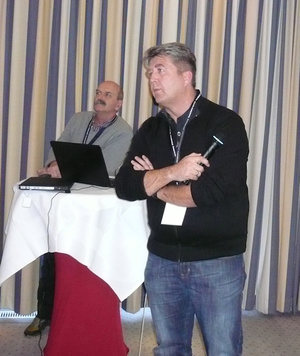
Speed Skydiving presentation by Arnold Hohlenegger following a brief introduction on his personal history and that of speed skydiving and its current competitive series; what the aim of the sport is and how it is judged. Both Sweden, U.K. and Austria have adopted Speed Skydiving as an official discipline and there have been demonstration events at the Mondial 2012 and DIPC 2013.
In the 2013 World Series Tour with 3 events in 3 countries and 60 participants from 10 countries participated. He then answered the question as to why he was here at the IPC plenary. It is the wish of the competitors and the ISSA will become part of the IPC family and that this will lead to greater exposure and more media possibilities. Their association has already put draft competition rules together and the necessary changes to Sporting Code Section 5. These papers are included in the annexes of papers for this meeting.
There was an interesting discussion from the floor.
After a much needed coffee break
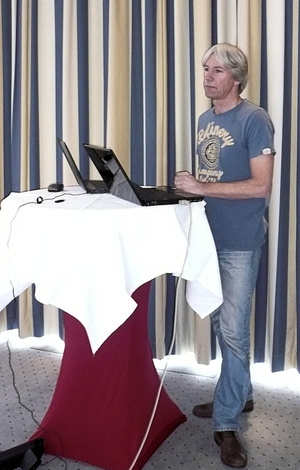
Ronald Overdijk then introduced the work of the Artistic Events committee. He spoke about a rule change proposal from the USA, but having taken a "Poll" on the Artistics Events Facebook page the result was opposition to the change and the committee will not support this proposal. There was some discussion from the floor.
He then handed the floor to Martin of Prostejov about a proposed change to the location of the World Championships in 2014. Move to a new and better drop zone, supported by the local council. Reduce the competition by one day. The new DZ in Prerov is 17 km from Prostejov. The new location has 3 big hotels, 1- 4 star and 2 - 3 star all very close to each other. It is only 5 km from the hotels to DZ. The control tower has air-conditioned rooms for Judges, Jury and competition organisation. New dining room for 300 people and hangars for packing and 300 skydivers.
The Russian delegate Vladimir Gazetov raised a question with regard to competitors entering two events, i.e. Formation Skydiving and also Artistic Events. There was a lot of discussion. But the rules in Sporting Code are very clear, the decision to enter both First Category Events is at the risk of the competitors. The organiser said they would obviously try to accommodation the teams, but this would have to be at his discretion and would depend on the weather and progress of the competition.
Ronald thanked the Czech Republic for their presentation and said obviously the change had to be voted for at the Plenary. There were no bids for 2015.
This was the end of the Open Meeting for the day - they will continue in the morning. Whilst delegates moved to the committee rooms to continue the committee work until the AGM of IPETA.
This was really a formal procedure that had to be gone through to prepare for the election of the 5 IPC directors to the Board. This election would take place during the Plenary. The two FAI directors have already been formally appointed, and Mr. Alvero de Orleans Borbon was at the meeting to represent the Shareholders of IPETA (the FAI) although with a 5 to 2 majority of the Directors being elected by the Plenary of IPC, IPC will maintain control of the company. The second FAI director is Mr. Otto Lagonhus, both FAI Directors are on the Executive Board.
Buzz Bennett presented the balance sheet for the year, although very little movement was shown other than the expenses of setting up and keeping the company within UK Company Law requirements and the payment to "Bushman" Anderson. This did cause some comments from the floor which were answered by Mr. Alvero de Orleans Borbon who said that he had authorised the payment, as an FAI loan, as he felt the opportunity for IPETA to present to a City Venue exhibition was too good to miss.
The real business of the next phase for IPETA will take place at the Plenary when a full presentation will be made.
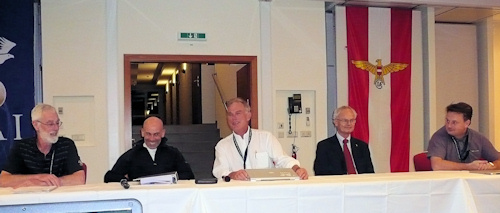
Mr. Buzz Bennett, Alberto Martin Paracuellos, Graeme Windsor, Mr. Alvero de Orleans Borbon and Ron Hughes (FAI Sports Director).
The meeting ended and tomorrow is another day. Still a lot of work to get done before the full Plenary on Saturday and Sunday.
30th January 2014
Day 2 of the open sessions
We start this morning with Canopy Formations, followed by the Judges' Committee. As I am involved with both these committees I will commence reporting after their presentations.

Lindy Rochow-Williams – introduced her committee and then went to the various proposals the committee have for consideration and approval or not, by the plenary. The first proposal related to viewing speed for judging. There was a proposal from the USA to introduce reduced speed viewing. The committee had discussed the proposal and had decided to introduce reduced speed only on the third viewing at the discretion of the Event Judge.
There then followed the USA proposal to change CR 2.3.2. Stairstep definition to remove the word “only” before A line. The committee did not accept this proposal and there was a long discussion from the floor. Although the USA argued strongly that this was a competitor driven wish other delegates said their competitors wished the word to remain and the Stairstep definition stays as it is.
The next proposal was to alter the definition of an “omission” and the committee had discussed it and was still working on this proposal and asked the floor for their comments. As there was none the committee will continue with their working on this for presentation to the Plenary.
The Determination of Winners return to original wording before the change made last year.
The last point was relating to the Absolute Rule was proposed to change from a unanimous decision of the panel to a 4-1 decision being acceptable.
There then was a long discussion from the floor from the Russian delegate regarding video presentation the response from the committee is that it is up to the team to decide where the camera is and they have the responsibility to show the grip.
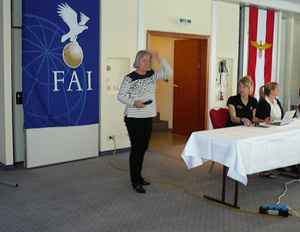
Next the Judges' Committee, chaired by Pia Berggren and she introduced the committee and commented on the missing member and how much Barry McAuley was missed.
Pia commenced by asking that the FAI Judges' lists displayed at the back of the room be checked by each delegation. In order to standardise the training of new judges the committee had decided to create a role of a Judge Training Co-ordinator, and they suggested Karla Cole (Germany) take on this position. Karla then made a presentation on how she visualised the role.
Training Courses and Evaluations – the courses planned for 2013 were cancelled due to lack of support and yet Pia then received requests for training from judges and it was too late. Pia appealed to the NACS to put forward early details of their judges who wanted to attend a course. On line course and Susan spoke about it and a “new” website.
Pia then moved to the committee still working on standards for scoring systems and apologised for the failure of the approved system at the S&A competition in 2013 and announced that this system was no long approved until brought in line with the required standards and would need to be reconsidered for approval.
Gillian then presented the proposed rule changes to chapter 6 of the Section 5 which is now an amalgamation of judge related items in both chapters 4 and 6. There was quite a long discussion from the floor regarding some of the proposed rule changes, particularly the decision to make the Judges' Committee and the Discipline Committee responsible for the nomination of Chief Judges for each FCE, obviously with the third balance provided by the Plenary vote.
There was also discussion around the decision to include in the rules the requirement for each judging panel to include a minimum of 1 or 2 newly qualified judges for each FCE, which in principle was well accepted by the meeting. There was further discussion regarding the number of judges required for an Indoor Skydiving FCE competition: One chief judge if FS & AE hosted on same venue + 4 AE judges and 11 FS judges.
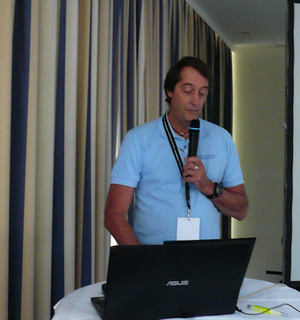
Formation Skydiving committee presented by Mark Szulmayer with apologies from Trude Sviggum for her absence due to a family death.
There were only a few rule changes to present to the plenary. A proposal to merge the VFS and FS document.
Wind tunnel rules – prepared by Rina Gallo and finalised by Trude Sviggum and the committee.
Request from France, from the floor, to replace the blocks removed from the dive pool for a 14 ft tunnel.
Change declaration of winner in a tie break situation, after a tie-break round, by taking the fastest time to the last formation in that round.
Request from the Czech Republic to enter more than one team at a FCE in VFS. Discussion followed.
The discussion was on two points 1. Did we want to change the number of teams for a FCE, as in AE and CF for VFS. 2. Does it want to happen in an on year or following the usual protocol of not making major changes on the on year. There was discussion on both points and this was put back to the committee for further consideration.
There then followed an excellent presentation from Skydive Chicago, USA for a Mondial 2016. There were few questions from the floor on the scheduling of the competition and the pricing on the bid document.
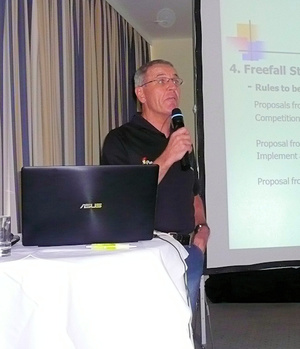
Style and Accuracy Committee, Chaired by Gunter Berendt.
Competitions in 2013 in Cheboksary, Russia. There was a low attendance at both the European Championships and the World Cup (only one Nation). All but the tie-breaks were completed and a total number of 278 style and 1101 accuracy jumps were made. There was a problem in the scoring section and this had not been inspected during the pre-competition inspection.
Gunter then presented his rule changes proposals. 5.1.3 and 5.1.7 to introduce the phrase “the competitor must make an immediate decision “ and take out the time reference. Canada thanks the committee for taking on board their proposal but asked why they did not accept 5.1.8 and received an acceptable response from the Chair.
A proposal from the Czech Republic to use a video system – the committee's response was to establish the facts at Banja Luka and discuss it at the open competitors meeting after and take their response back to the committee.
A proposal from the USA for a new record in Freefall Style. In Accuracy and Canopy Piloting there are both performance and competition records. The proposal is to introduce a similar record available for style, i.e. a single set would be considered a performance record, whereas we would also have a five set style record set at a competition to be a competition record.
After a break for lunch we returned to the Style and Accuracy Committee and the Bid Presentation from Bulgaria for the European Championships in Style and Accuracy 2015.
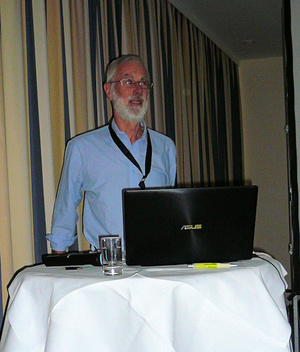
Rules and Regulations Committee Introduced by Buzz Bennett, the committee consists of Liam McNulty, Gillian Rayner, Ronald Overdijk, Elisabet Mikaelsson, Susan Dixon, Jim Hayhurst and Doris Merz and Mubarak al Swailim.
Starts with the Routine Section 5 amendments, item 3 has already been covered, and other IPC documents (Jury handbook etc.). There then followed several proposals from Alberto a couple of which have already been dealt with.
We then come to the Section 5 proposed amendments and the majority of the changes are “housekeeping” cleaning up the language and making it clearer without altering the intent of the regulation.
We then covered Annex 56 – protest time limit. This was introduced by Alberto and he spoke about the reasoning behind his introduction of this proposal. The committee discussed it and does not support it. This will be voted on in the Plenary, there was some discussion from the floor.
The next two Annexes have been covered by other committees.
The next Annex related to the Sporting Licence and proposed by Alberto and he suggested that the FAI Database is utilised instead. Gillian Rayner read out an e-mail saying that this was now in place on the FAI website. Rob Hughes spoke to the meeting to say this is something he has been working on within FAI for 10 years. The system will now be mandatory for all NACs registering their athletes on the FAI database by 11th March 2014. Paper licences will no longer be valid.
Niels-Christian Levin Hansen proposed under any other business that the committee alter the regulation that the Current World Record be posted at a FCE and the Current Rankings for the relevant discipline. Tthe committee agreed to do so.
That concluded the formal business of the open meetings. Now the work begins in the committees.
Friday is a day of Closed Committee Meetings and a lot of work is done by all delegates present either within the committees or "lobbying" for support be it for a bid to host a competition, future plenary or the positions on the Bureau which will be subject to an election on the final day.

